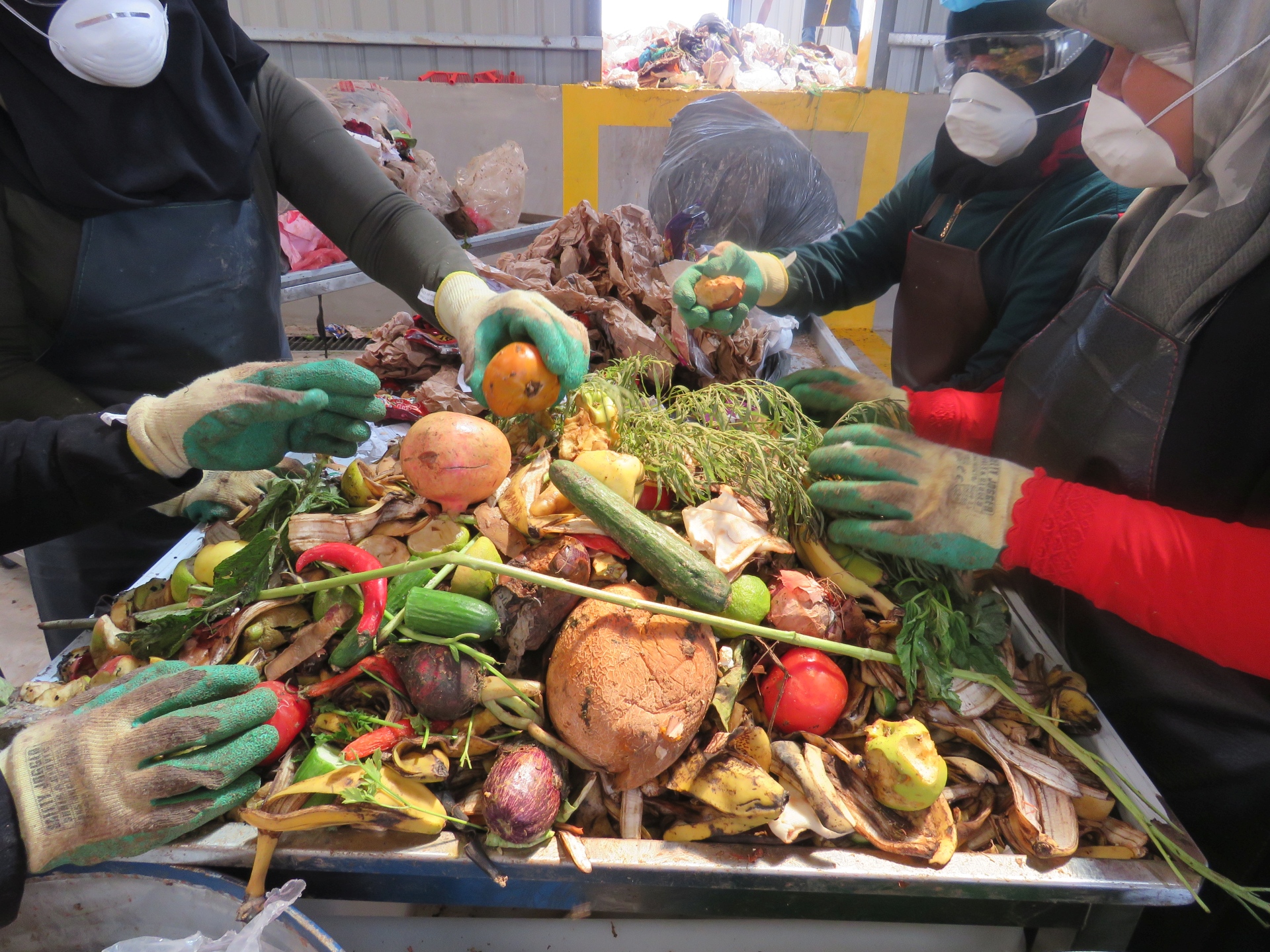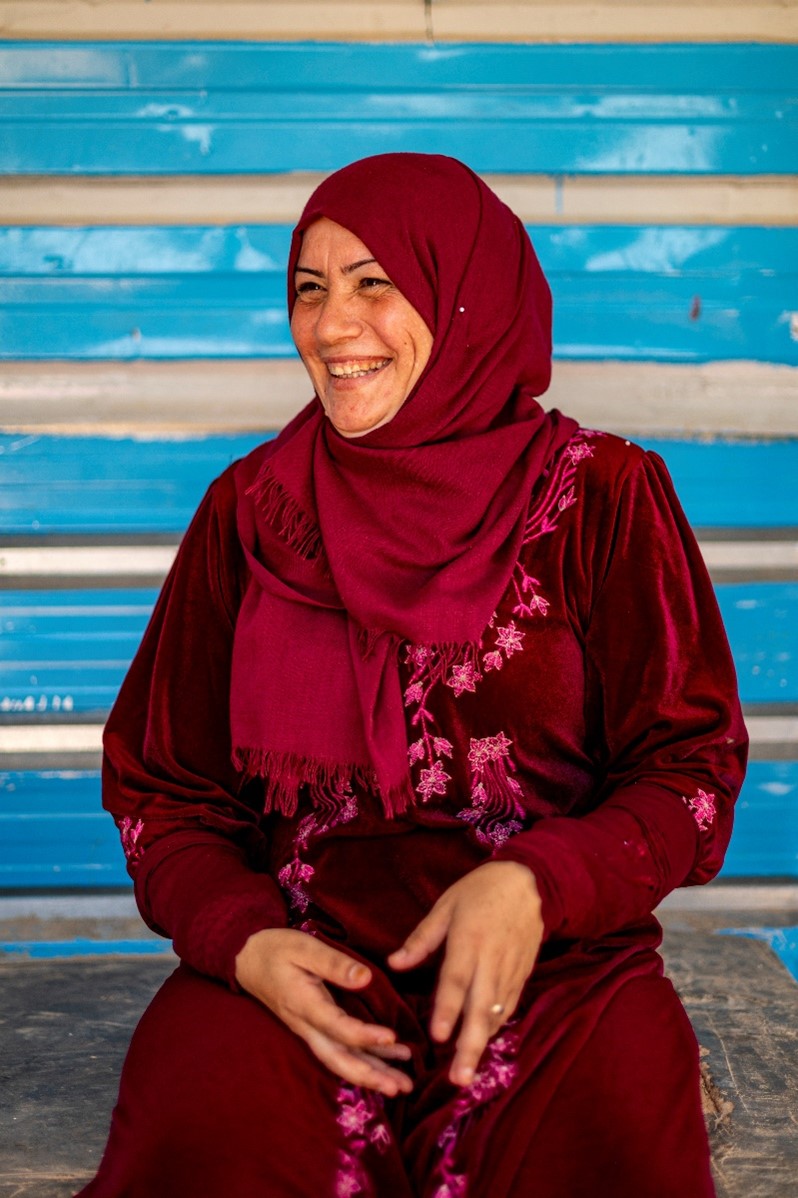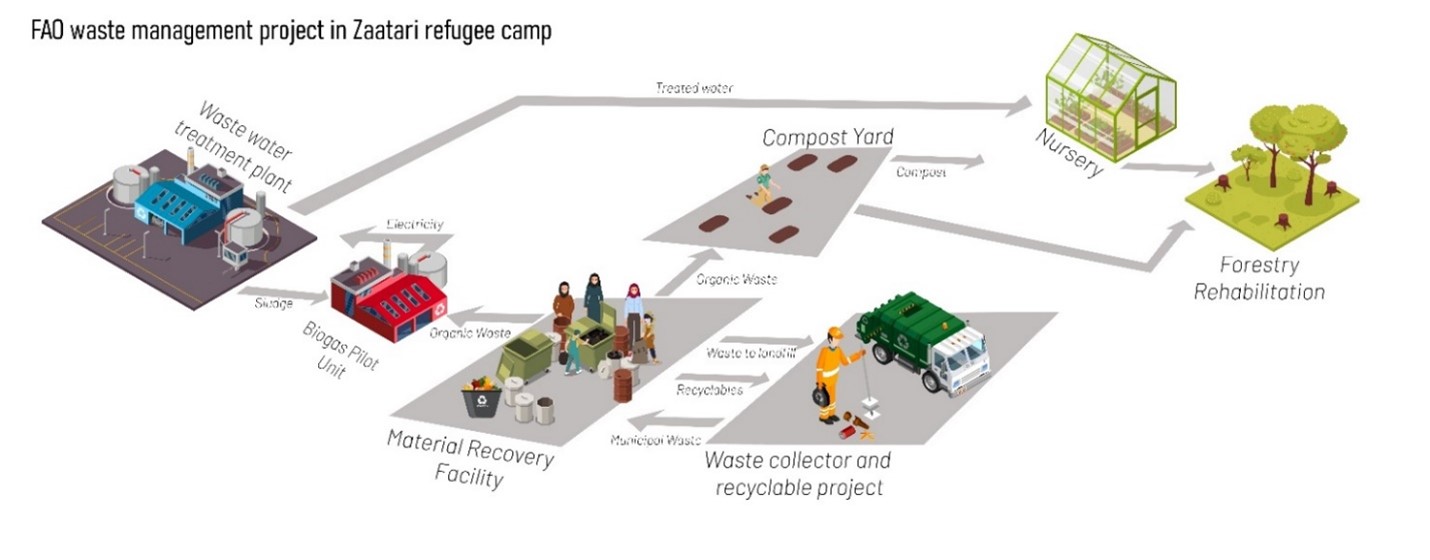
Circular waste management in Zaatari - refugee camp Turning waste into compost, energy, and job creation
Good Practice – Lessons learned.
Workers working in compost yard
©FAO/Imad Alquran
02/01/2024
Location: Jordan, Mafraq Governorate, Zaatari refugee campDate: October 2019 – March 2024
The Zaatari refugee camp located in the North of Jordan was established in July 2012 to host the Syrian refugees, who have been forced to leave their homes. With the camp hosting around 80 000 Syrian refugees, it became the largest Syrian refugee camp in the world.
The camp is located in Mafraq Governorate, which is one of the most vulnerable areas in Jordan since the poverty and unemployment rates in the governorate are higher than everywhere else in the country. Many other challenges face Syrian refugees in the camp such as access to water, lack of livelihood opportunities and the reliance on humanitarian aid or informal labor.
In addition, the camp produces a huge amount of waste daily, leading to a harmful effect on the infrastructure in the governorate and the environment as well. The camp also has a tremendous daily need of energy to keep the facilities running.
With these challenges and difficulties, there was a need for an intervention that could facilitate the lives of Syrian refugees alongside the local communities in the region and improve the quality of life in the camp.
Key Facts
Implementing partners: FAO, Ministry of Agriculture in Jordan, Syrian Refugee Affairs Directorate, UNHCR, Jordanian National Agriculture Research Center (NARC), Jordanian Energy Research Center (NERC), Oxfam and GIZ.
Donor: the European Union Regional Trust Fund in Response to the Syrian Crisis (EU MADAD)
Target Group: 315 direct beneficiaries of temporary job opportunities (40 percent women, 59 percent Syrian, 41 percent Jordanian), benefiting 1 613 household members. In addition to, Syrian refugees living within the Zaatari camp (indirect beneficiaries).
Key resilience dimension
The European Union-FAO waste management pilot system intends to establish a circular economy model by using the resources generated by the interconnected process. Compost, biogas/electricity, and treated wastewater from the Wastewater Treatment Plant (WWTP) in the Zaatari camp are used to obtain tree seedlings, creating job opportunities for both refugee and host communities.
The circular economy model for waste management in Zaatari camp connects waste management, sludge treatment, and energy generation with seedling generation for rehabilitating forests and range lands in the host communities. It allows for revenue generation, green job creation, and cost reduction of waste management.
This constitutes a solid and effective approach towards the humanitarian–development nexus. It improves the resilience of both refugees and host communities through income generation opportunities, but also through the development of innovative solutions to increase reliable energy production, reduce pressure on water and land, and improve the sustainability of rehabilitated forests and rangeland.
Cross-cutting themes
Gender
In the Zaatari camps, around 22 percent of work permits have been granted to women. The economic participation of women Syrian refugees remains limited though while 30 percent of households in the camp are female headed. Women usually work in seasonal agricultural labour. The waste management plant offers a non-agricultural employment opportunity to Syrian women.
Research
Research is integrated into circular waste management activities. In the long term, experimental research carried out by NARC focuses on assessment of the compost safety and quality. Forest and range land seedlings are produced on-site using compost, treated wastewater and dry sludge. Ultimately, FAO and NARC wish to extend the research to provide evidence on the safety of treated wastewater use agriculture.
Context
Since the start of the Syrian Crisis in 2011, more than 5 million Syrians have been forced to leave their home and seek refuge in neighboring countries and across the world. Located in the Northern Jordanian arid steppe near the city of Mafraq, the Zaatari refugee camp was established as early as July 2012 as a temporary shelter. Twelve years into the protracted Syrian Crisis, the camp is home to around 84 000 Syrian refugees and has grown into a busy quasi-permanent urban settlement. It is the largest Syrian refugee camp in the world.
FAO, in collaboration with the Ministry of Agriculture, the camp authorities, NARC, the National Energy Research Center (NERC) and Oxfam, has commenced a circular approach to waste management in the camp. The established Material Recovery Facility (MRF) allows for the sorting and recycling of waste. It is linked to a compost production unit and a biogas plant.
Zaatari camp waste management facility is also used for research and certification purposes. The compost produced is approved by NARC for use in agriculture. Research could potentially expand to assess the feasibility of the use of treated wastewater for irrigation.
Challenges
There is a particular concern in terms of the impact of the Syrian crisis on Jordan's Northern governorates, which host the highest number of refugees, and the consequent pressure on local service delivery, natural resources, and the local labour market. The impact of the Syrian crisis on agriculture and food security includes increased pressure on natural resources, including land and water. It is estimated that the water demand has increased by 40 percent in the Northern governorates compared to 21 percent in the rest of the country.
Now the size of a small city, the Zaatari camp produces around 34 metric tons of waste daily. The tonnage generated is regularly transported to external landfills via diesel-driven dump trucks, a process which exerts enormous pressure on infrastructure, municipal services, and the environment. Furthermore, it is estimated that the camp has a daily energy need of 100-120 kWh.
Implementation and objective
The Zaatari waste management facility has been operational since January 2016. The action was consolidated through the introduction of circular waste management approaches through the “Enhancing resilient livelihoods and food security of host communities and Syrian refugees in Jordan and Lebanon through the promotion of sustainable agricultural development” project funded by the EU Regional Trust Fund in Response to the Syrian Crisis (EU MADAD). The project was implemented between October 2019 and March 2024.
The objectives were to:
- Sort and recycle part of the waste generated within the Zaatari Refugee camp (glass, metal, plastic, paper, and organic waste).
- Produce energy using waste and sludge.
- Produce compost using sorted organic matter.
- Using the resources (energy and compost) generated by the project to produce forest and rangeland seedlings.
- Create green jobs for Syrian refugees.
- Use the project infrastructure to undertake research on the inter-relations among biosolid, compost and treated water for food crop production.
Ultimately, one of the objectives was to capitalize on the project activities to increase the public and policymakers’ awareness of the positive impact of the circular economy model of waste management and on the potential use of organic compost, sludge, and treated wastewater in agriculture activities.
Methodological approach
The circular process
The first step of the process starts with the daily arrival of 16 metric tons of municipal waste from the Zaatari camp to the on-site Material Recovery Facility, i.e. the sorting unit. Waste is sorted into the following:
- Plastic, metal, glass, and paper are collected and handed to a project partner for recycling.
- Organic waste is used on-site, partly composted on-site and partly used for the generation of energy through an on-site biogas production unit. The biogas pilot unit used both sludge from the adjacent wastewater treatment plant and organic waste from the MRF to generate electricity with a capacity of 50 kWh / day.
- The remaining wastes are sent to a local landfill.
The compost is tested for conformity with Jordanian governmental standards and used for the conditioning and enriching soils of on-site forest and range land seedling nurseries. Seedlings produced at the site nurseries are used in national reforestation programmes across Jordan. The use of compost has been shown to enhance seed germination and the chance of field survival seedling under salinity stress.
Job creation
Syrian men and women have been offered job opportunities through a cash-for-work scheme on-site. Selection of beneficiaries has been made based on vulnerability criteria. While the project initially sought to employ both refugee and host communities, access to camp facilities became a logistical concern in targeting outside workers, since permits would be needed. However, a workaround was devised by hiring Jordanians as contract workers to build the waste management infrastructure and the tree nursery, making them eligible for camp permits and succeeding in bringing host communities into the Zaatari camp, contributing to both host community and refugee income generation.
Results and impacts
Job creation. The intervention has charted a way forward for a new income stream within the camp, providing a skilled livelihood that is both dependable and ecologically forward-thinking. A total of 315 direct beneficiaries of temporary job opportunities (40 percent women, 59 percent Syrian, 41 percent Jordanian) have been employed on the site benefiting around 1 613 household members. A specific focus has been made on the selection of women workers, especially women of households.
“I needed many things for my house, and when I started working, I was able to buy them. My daughter was sick, and I was able to have her treated.”
-Abdel Wadud, a Syrian refugee who was employed by the project.
Waste management. The extraction and reuse of organic material from the camp’s waste has resulted in less waste being transferred to local landfills. This eased the strain being placed on camp infrastructure and services, as well as the sensitive ecological system of North Jordan's arid steppe. The project has also significantly reduced CO2 and methane gas emissions from landfills, in addition to cost and emission savings resulting from the reduction in waste transfer from the camp to the land field. In total, it is estimated that the project has reduced landfill dumping by around 1 560 tons, producing 185 tons of compost, and saving around USD 30 000 in transportation costs. Savings are expected to grow as the project streams scale up and the potential for electricity generation is further developed.
Research. Biogas yields are analyzed in collaboration with the National Energy Research Center (NERC) strengthening the national capacity of biogas. A biosolids research component of the project was concluded in early 2019 and its findings were presented to national stakeholders. Further research studies have been conducted in partnership with NARC concerning the effect of composting on crops, namely if it can reduce irrigation water, maximize crop yields organically, or minimize the adverse effects of saline irrigation water and saline soils on crops. The research presented key findings that organic waste positively enhances seed germination and survival under salinity stress, with recommendations to use compost for improving seedlings (forest trees, range land and crop plantation) and plant nursery production.


FAO waste storing facility in Zaatri camp. ©FAO/Imad Alquran - Female workers sorting the waste into different categories, ©FAO/Imad Alquran
Sustainability
The circular economy: a sustainable economic model. The net savings in the waste management costs and the generation of valuable resources such as biogas/electricity, compost, and seedlings for rehabilitating natural resources ensures the sustainability of the model.
Building financial resilience. Following the interruptions caused by COVID-19, an additional component of the project revolved around the creation of a new community-based savings and loans association for waste workers based on the existing concept of Jamieh, a social informal funding mechanism traditional to the Middle East. The shared association is designed to cushion beneficiaries against further interruptions in work. On top of the workers’ salaries, a one-time cash payment was provided to beneficiaries’ households (refugees and host communities), with plans to integrate other income-generating activities.
Linking the activities to policy development. Thanks to evidence-based research, FAO is providing technical support to Jordanian authorities to improve the green energy and agriculture policy framework. Currently, the use of biosolids in land application is prohibited in Jordan. The project helped establish an ad hoc national technical committee to look at the main gaps at the policy and legal framework level as well as support the harmonization of conflicting biosolids standards in Jordan. FAO convened an in-depth national dialogue with relevant stakeholders and relevant ministries to inform policies and decision-makers on the safe use of biosolids in agriculture. In May 2021 the relevant public institutions were convened by FAO and reached an agreement to harmonize the national standards and allow for the use of biosolid in fodder production, as well as forest and rangeland rehabilitation.
Further advocacy efforts are planned to support the use of treated wastewater in irrigation in food crops.
Replicability & upscaling
Meeting the longer lifespans of refugee camps. The project, which provides new avenues for income generation while reducing the ecological and infrastructural strain of waste production, can be replicated in other refugee camp contexts. UNHCR estimated that there are more than 70 million people forcibly displaced worldwide. Like Zaatari, refugee camps around the world have evolved from temporary shelters to semi-permanent settlements, with average lifespans lasting 10 or 15 years, or even longer. The Zaatari facilities' technical specification and implementation methodology are well documented by the FAO can be shared and is adaptable in other contexts.
Food production. FAO is looking to scale up the initiative by introducing food production through hydroponic and vertical gardening methods, using treated wastewater.
Key learning
The integration of research and advocacy is key for the long-term sustainable impact of the project. Such pilot activities can lead to significant policy changes, which in turn can lead to a highly positive impact on both the environment and household living conditions. The early involvement of public authority improves the chance of success, synergies between institutions involved in the food-energy-water nexus, and the potential for national-level impact. Similarly, early project stage coordination with other UN agencies and camp management is important to ensure the effectiveness and efficiency of the intervention.
Finally, the scaling-up of the operation is important to ensure the financial sustainability of the process and its ability to maintain and expand job creation in the long term, a green business model should be assessed, developed, and implemented to ensure long-term financial sustainability.
Related links

From the field
“After I finished paying back my debts, I started improving my house and made it bigger. It was very beneficial for me, thank God. I can’t wait for the morning to come to go to work because it is full of enthusiasm, and people started seeing me differently.”
Jamilah, a Syrian refugee
Jamilah’s Story - Waste Management to Enhance Livelihoods in Zaatari Refugee Camp

